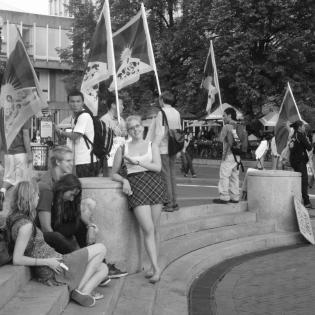Taking a Stand for Good
Youth read about Rosa Parks and evaluate how her protest of an unjust situation was philanthropic in nature. They learn that there are 198 methods of non-violent protests that can be used to fight injustice. The youth evaluate issues of inequity or injustice and propose nonviolent solutions.
The learner will:
- describe the contribution Rosa Parks made during the civil rights movement.
- recognize the various methods of non-violent protests and explore nonviolent solutions to difficult situations.
- identify acts of non-violent resistance as acts of philanthropy.
- photo display of Rosa Parks or the bus on which she refused to give up her seat; available on the Ford Museum website
- student copies of the 198 Methods of Non-Violent Protest
- group copies of handout: Five Scenarios and Discussion
Curating and Preserving the Rosa Parks Bus, The Henry Ford, www.thehenryford.org/explore/inside/rosa-parks-bus/.
Kelley, Robin D. G. Race Rebels: Culture, Politics, and the Black Working Class. New York: Free Press, Distributed by Simon & Schuster, 1996. ISBN 0-684-82639-
Instructions
Share this quote from Rosa Parks: "I'm just an average citizen. Many black people before me were arrested for defying bus laws. They prepared the way."
Talk about the actions of Rosa Parks that led the way to equity on Montgomery, Alabama buses. The nonviolent bus boycott in 1955-56 raised awareness of unfair laws and practices and forced the city to change them.
Share the list of 198 Non-Violent Protests (link above) and ask youth to scan the list to find the nonviolent technique Rosa Parks used. Then have them name the methods they know about. Discuss:
- “Which of these methods do you feel is effective in creating change?”
- “Which of these methods were used by Civil Rights leaders that you’ve learned about in history?”
An optional extension activity is to have the youth research an unfamiliar method on their own and present a description to the group with documentation of their sources.
Define philanthropy as "giving time, talent, or treasure for the sake of another or for the common good." Talk about social action as philanthropy.
Discuss how non-violent protests result in making life better for oppressed individuals. In other words, the protesters are giving their time and talents to demand change. Brainstorm ways young people can promote justice and kindness in a nonviolent way. How can they use their voice to promote the common good?
Philanthropy Framework
-
Strand PHIL.I Definitions of Philanthropy
-
Standard DP 01. Define Philanthropy
-
Benchmark HS.1 Define philanthropy to include giving and sharing; volunteering; and private individual action intended for the common good. Explain how a volunteer individual/group can act for the common good.
-
Benchmark HS.2 Identify and discuss examples of philanthropy and charity in modern culture.
-
-
Standard DP 02. Roles of Government, Business, and Philanthropy
-
Benchmark HS.2 Provide examples from history of how the relationship between government and the civil society sector has changed.
-
Benchmark HS.6 Describe how the civil society sector is often the origin of new ideas, projects and innovation and social renewal.
-
Benchmark HS.7 Describe how the civil society sector provides mediation for individuals and governments.
-
-
Standard DP 03. Names and Types of Organizations within the Civil Society Sector
-
Benchmark HS.1 Recognize and use a variety of terms related to the civil society sector appropriately, and identify the characteristics the terms describe.
-
-
Standard DP 06. Role of Family in Philanthropy
-
Benchmark HS.3 Identify how subgroups and families in society demonstrate giving, volunteering, and civic involvement.
-
-
-
Strand PHIL.II Philanthropy and Civil Society
-
Standard PCS 01. Self, citizenship, and society
-
Benchmark HS.2 Discuss and give examples of why some humans will sacrifice for the benefit of unknown others.
-
Benchmark HS.3 Give examples of human interdependence and explain why group formation is one strategy for survival.
-
Benchmark HS.4 Describe and give examples of characteristics of someone who helps others.
-
Benchmark HS.5 Describe civil society advocacy organizations and their relationship to human rights.
-
-
Standard PCS 02. Diverse Cultures
-
Benchmark HS.2 Give examples from history of how intolerance of ideas, religion, and minorities contributed to social disintegration.
-
Benchmark HS.5 Describe how women and minority groups have used the civil society sector as an alternative power structure.
-
Benchmark HS.7 Identify and give examples of the important roles women and minorities have played in the civil society sector in history.
-
-
Standard PCS 05. Philanthropy and Government
-
Benchmark HS.10 Discuss the results of private citizen voluntary action intended for the common good on public policy changes.
-
Benchmark HS.12 Explain why private action is important to the protection of minority voices.
-
-
Standard PCS 06. Philanthropy in History
-
Benchmark HS.2 Give an example of individual philanthropic action that influenced national or world history.
-
Benchmark HS.3 Describe important events in the growth and maturation of the civil-society sector in the nation and world.
-
Benchmark HS.5 Identify positive philanthropic historic acts or events that helped build the community, state, and nation.
-
-
-
Strand PHIL.III Philanthropy and the Individual
-
Standard PI 01. Reasons for Individual Philanthropy
-
Benchmark HS.1 Define and give examples of motivations for giving and serving.
-
Benchmark HS.10 Identify reasons why historic figures acted for the common good.
-
Benchmark HS.4 Cite historical examples of citizen actions that affected the common good.
-
Benchmark HS.9 Describe the concept of volunteerism in different world cultures.
-
-
